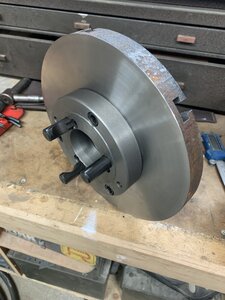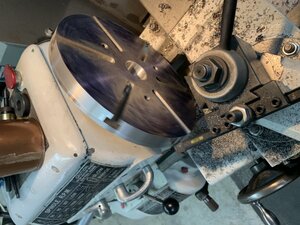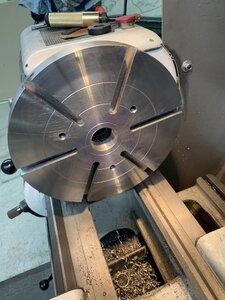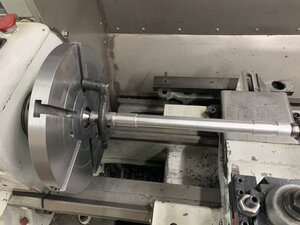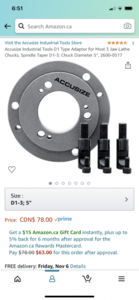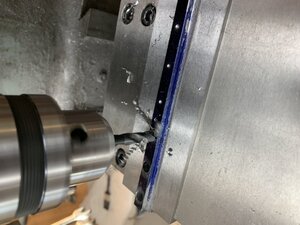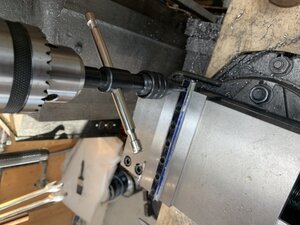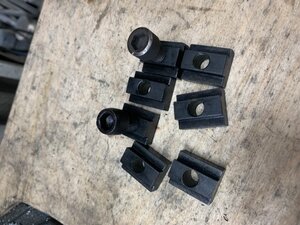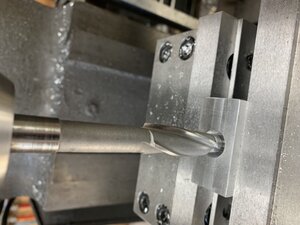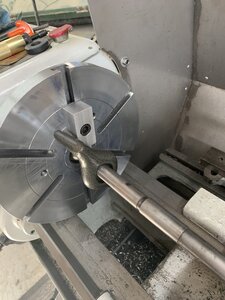Brent H
Ultra Member
@YYCHobbyMachinist has a thread about looking for a lathe face plate and drive plate so I thought I would build one that will do both. @PeterT just made a fixture plate for his rotary table and that type of plate could also be used for the lathe face plate application.
The face plate on a lathe can be used to turn or face odd shaped items and has a bit more versatility than a 4 jaw chuck for some odd shapes - you just need to watch how you balance the weight so as to avoid as much vibration as possible. Typically the face plate has a centre hole that allows you to insert a dead centre into the spindle of the lathe. Mine is a #4 Morse taper. This will allow you to turn between centres.
Most lathes are sized by the diameter they can turn and the length. Typically that length is greatly reduced when you add a chuck as the length is given between centres. Turning between centres allows the project to come off the lathe for checking fits or even transferred to other lathes with out impacting the accuracy of the turning. You can do it using your chuck, a centre inserted into the chuck, cleaned up on the lathe and then use the jaws of the chuck to drive the dog holding your work piece. You can also do it by installing a drive plate and using a centre in your lathe spindle. This can add several inches of extra length if your project requires it.
For my project I will be making a face plate (you can bolt work on) and also add a fixture for use as a drive plate for “L” shaped lathe dogs. The straight dogs require a bolt to engage the drive pin on the dog. This would also be easy on this type plate.
The plate I am making is 9” OD (I have a 10” lathe) and 7/8” thick. It is mounted to a D-3spindle adaptor plate.

some Bluing to get a rough layout. I stamped a deep centre punch approximately in the centre
I set things up on my mill on top of a large (12”) rotary table and drilled and tapped for the D-3 adaptor. Holes are threaded for 3/8-16

Once that was done I milled slots in at every 60° using a 3/8” carbide 4 flute end mill (additional 0.020” on either side of the slot for clearance) and then milled out the “T” using a special purpose T slot end mill for 3/8” bolts.


More coming....
The face plate on a lathe can be used to turn or face odd shaped items and has a bit more versatility than a 4 jaw chuck for some odd shapes - you just need to watch how you balance the weight so as to avoid as much vibration as possible. Typically the face plate has a centre hole that allows you to insert a dead centre into the spindle of the lathe. Mine is a #4 Morse taper. This will allow you to turn between centres.
Most lathes are sized by the diameter they can turn and the length. Typically that length is greatly reduced when you add a chuck as the length is given between centres. Turning between centres allows the project to come off the lathe for checking fits or even transferred to other lathes with out impacting the accuracy of the turning. You can do it using your chuck, a centre inserted into the chuck, cleaned up on the lathe and then use the jaws of the chuck to drive the dog holding your work piece. You can also do it by installing a drive plate and using a centre in your lathe spindle. This can add several inches of extra length if your project requires it.
For my project I will be making a face plate (you can bolt work on) and also add a fixture for use as a drive plate for “L” shaped lathe dogs. The straight dogs require a bolt to engage the drive pin on the dog. This would also be easy on this type plate.
The plate I am making is 9” OD (I have a 10” lathe) and 7/8” thick. It is mounted to a D-3spindle adaptor plate.

some Bluing to get a rough layout. I stamped a deep centre punch approximately in the centre
I set things up on my mill on top of a large (12”) rotary table and drilled and tapped for the D-3 adaptor. Holes are threaded for 3/8-16
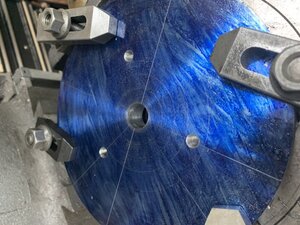
Once that was done I milled slots in at every 60° using a 3/8” carbide 4 flute end mill (additional 0.020” on either side of the slot for clearance) and then milled out the “T” using a special purpose T slot end mill for 3/8” bolts.
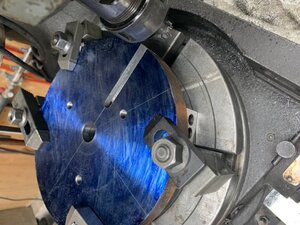
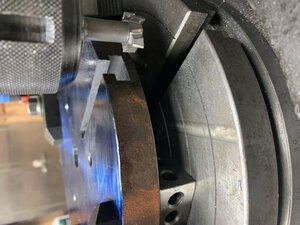
More coming....

